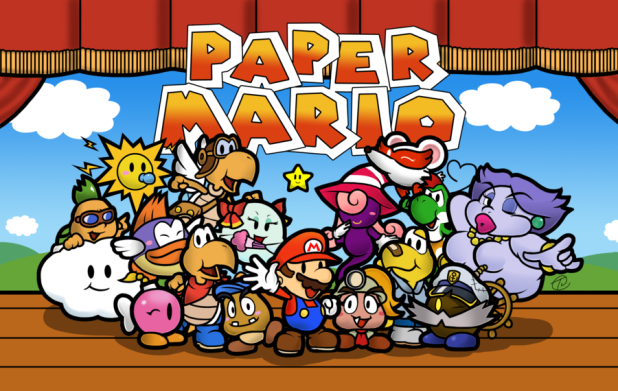Features
‘Paper Mario: Sticker Star’ – A Case Study in Failing your Franchise
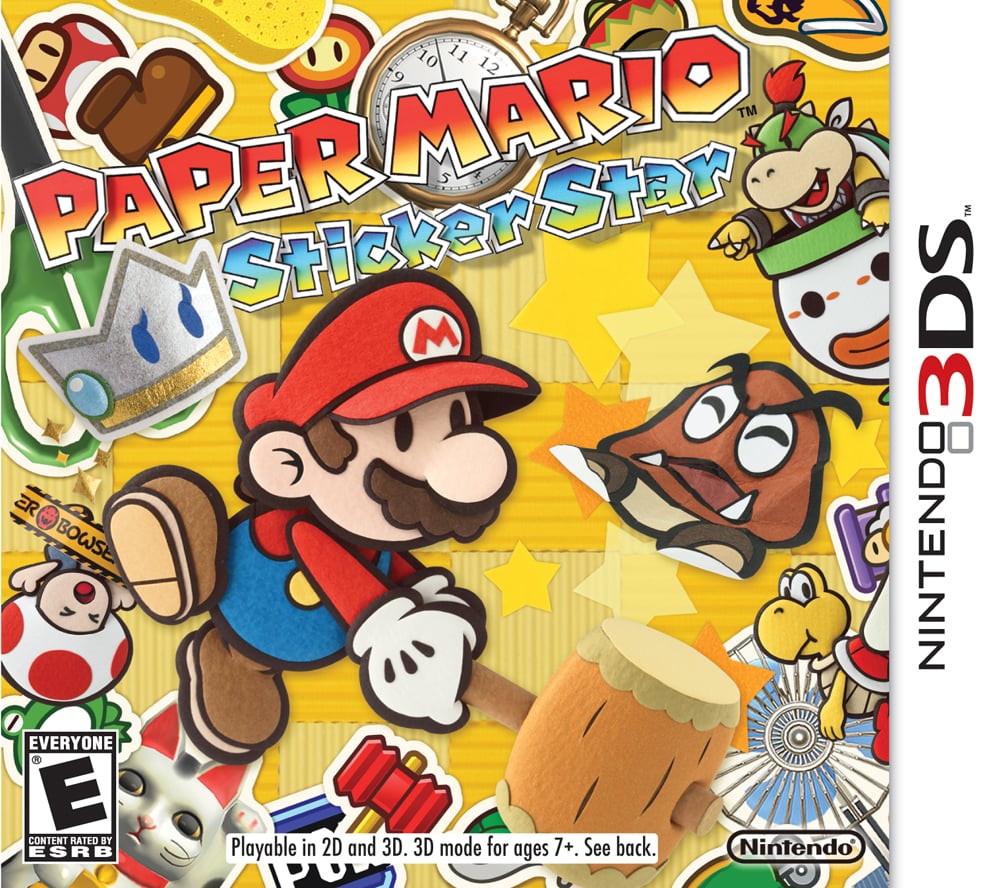
Super Paper Mario’s main gameplay hook involved swapping dimensions to show how different perspectives can yield two fundamentally different realities. In the 2D view, a series of blocks surrounding a door would hinder your progress, while the 3D view reveals that the blocks are actually disjointed and you can easily slip through the cracks. This mechanic ends up being tragically fitting when looking at that game’s successor. While Paper Mario: Sticker Star may have the looks and sounds of a Paper Mario game, that illusion is paper thin and fails to mask the broken mess this game truly is.
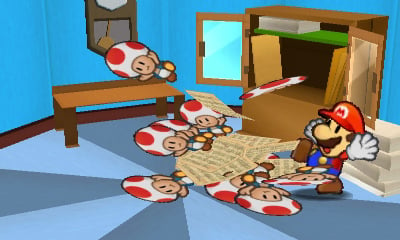
To be clear, a broken game is not necessarily one that’s unplayable or filled with bad ideas, but rather can be the result of those ideas not working together. In isolation, some of the design decisions made in Sticker Star could have made for a compelling game. Unfortunately, the source of Sticker Star’s problems stem from this weird attempt of trying to cater to both those who seek innovation and those preferring to stick to formula. In the process, it needlessly discards some of the series’ defining attributes and overly relies on a poorly thought out new game mechanic that doesn’t gel with what remained.
The most notable omission from Sticker Star has to be its near total lack of plot and character. This was supposedly influenced by the legendary Shigeru Miyamoto, whose major design philosophy is that the gameplay itself should be fun enough that a story would be inessential. While this is an understandable position, it’s worth remembering what role character-fueled narratives fulfilled in RPGs to understand what happens when they’re removed.
While traditional Mario games tend to have finely-crafted engagement curves thanks to its linear level design, traditional RPGs are longer and more open-ended. Consequently, that level of freedom and scale means it’s much harder to make every single section of the game interesting regardless of how fast or slow you play it. Inevitably, the player will be put in a position where they must perform tasks that are intrinsically not fun (be it backtracking, grinding, or completing repetitive quests). One way to avoid these pitfalls is to provide that sense of context found in narrative-rich games. Done correctly, they can instill a sense of purpose in the player, lessen repetition thanks to varied character interactions, and give the players something meaningful to contemplate as they play through less exciting sections.
Fortunately, the Mario RPG series has been generally quite reliable at telling engaging stories with an intriguing cast by taking the familiar staples of the mushroom kingdom and cleverly subverting them. The original Paper Mario began with the typical premise of Bowser ruining Mario and Peach’s love life, but then twists it by not only having the player fight Bowser at the beginning of the game, but actually end up losing to him. That moment is crucial because it suddenly changes what you expect to see in a Mario game, and prepares you for the weirdness the game throws at you. You get to meet actual personified versions of Bowser’s minions who’ll fight alongside you. You get to see what being the kidnapped princess is actually like in Peach’s playable sections. There are even surprisingly dark storylines involving an invincible monster who eats Boos, or Mario being the primary suspect in a murder for which you must clear his name. Its sequel, Paper Mario: The Thousand Year Door, managed to up the ante further with even more fleshed-out characters and so many wickedly imaginative plotlines that made it seem like anything was possible. This level of subversion goes beyond the games merely having a sense of humour. Sticker Star may still have funny writing, but with no plot or character for that dialogue to be in service towards, it becomes meaningless filler.
Providing meaning to both plot and character is one of the pillars to ensure the player is motivated to want to pursue and complete any game. It mattered beating Bowser at the end of Paper Mario because of how badly he trounced you at the beginning. It mattered beating the Shadow Queen because she’s possessed Peach (who you’ve spent time with, and hence care for her well-being) and is threatening to destroy the world populated with all the colorful individuals you came across on your adventure. What possible reason is there to care about getting to the end of Sticker Star? To save Peach? She does nothing in the entire game and it’s not like this is the first time she’s been kidnapped… To defeat Bowser? He doesn’t even have a line of dialogue, and isn’t exactly having much of a negative effect on the world. To save the people you met on your travels? What people? Apart from that Wiggler, every other character is just some boring colour variation of the same snarky and cowardly toad.
It’s not like they had any fellow party members to get attached to. In the past, they each represented a specific part of the world and had unique skills and attributes. They wouldn’t just randomly join you; you had to earn their favour. They all had distinct personalities and generally felt like people that’d be fun to hang out with. This is what made their use in combat so potent, because not only did their unique characteristics carry over to battle, but the nature of the gameplay itself creates opportunities such that you’ll both help each other during dire moments. While Kersti (your sole companion in Sticker Star) isn’t a terrible character by any means, she’s so uninvolved with the moment-to-moment gameplay that it makes it really hard to care for her even when she goes to the length of sacrificing herself in the final fight. Without that bond between player and character organically forming during the battles, partners hold no further purpose than granting the player an extra turn in battle.
While the omission of these contexts certainly takes away from the mood of the combat, this doesn’t necessarily doom the gameplay. Miyamoto’s principle does ring true for other games after all, and the Mario RPG series has always benefited by having a more active battle system than many of its peers. And at first glance, there don’t appear to be nearly as many missing features from it. Turn-based combat returns, with the traditional assortment of basic and advanced attacks to be used strategically against enemies based on their different strengths and weaknesses. Yet in their attempt to innovate with their new sticker mechanic but hold on these RPG trappings, a fatal defect emerges. By tying into the amount of stickers collected with the amount of times you can attack in battle, you become hopelessly powerless without them.
This problem may not have been highly prioritized since stickers can be found nearly everywhere and are relatively cheap to buy. Though you cannot endlessly hoard them, actually running out of them should be unlikely. In practice, while ending up with zero stickers seldom happens, ending up with zero useful stickers happens all too often. Consider that there’s no way of knowing what type of enemies will be fought next, and hence little way of knowing which stickers should be saved and which can be dispensed of now. To compensate for this, it’s only natural to use basic jump and hammer attacks since they’re the most commonly found. This is similar to how traditional Paper Mario games approached combat, but differs by providing the player with fewer options.
Paper Mario had default attacks with jumping and hammering that could always be used. They were designed to be a failsafe if you were out of resources, or if it happened to be the most efficient tactic at your disposal. Stronger and more strategically viable attacks, however, all consumed either Flower or Star points. This allowed them to communicate the idea that powerful moves should be used sparingly, but not limit what choices you could make provided you could afford it. The way Sticker Star makes every attack consumable though is as if they made every single move at your disposal come with one of those point bars. Or, to put it another way, like they decided to replace all of your abilities with the single use items found in the first two games. This sort of resource consumption mechanic has more in common with Resident Evil 4 than a Paper Mario game. It’d be one thing if the game was designed around instilling tension and fear in the player, but in an upbeat game like this one, all it does is add an unnecessary amount of stress on the player. It’s enough to make one want to avoid the combat altogether.
Incidentally, much like how the game provides no incentive to seeing the end of the game, it provides no incentive to even fight the enemies along the way. Battles no longer reward you with experience points, as the only means of improving your stats stems from beating chapters and finding special hearts. Instead, winning fights rewards you with coins, and the occasional sticker. Coins are used to buy stickers which, apart from being found nearly everywhere for free, have one main use; to be used in combat. But since only a handful of fights are actually mandatory, it makes one wonder about just avoiding all the fights and keeping whatever stickers were lying around. You can even still earn coins just by beating a chapter in case you were worried about not being able to fund the in-battle slot machine for when you actually do have to battle. It should never be a viable strategy for the player to skip a primary component of the game’s content.
The only truly new idea that Sticker Star has to offer lies with the poorly named “thing stickers”. These are rarer than regular battle stickers and more versatile, since they’re also used for puzzle solving. Truthfully, there are moments when this mechanic shines. Sticker Star is a refreshingly ruthless game that does not feel the need to plainly outline how to solve its puzzles, which makes the discovery of the solution all the more satisfying. Their diverse battle animations also add a much needed visual variety to combat which can freshen up otherwise dull encounters. Unfortunately, these highs are spread few and far between thanks to a number of sticky frustrations that come along with them.
While thing stickers are like regular stickers in that they can only be used once before being discarded, their rarity requires you to go to the hub town to replenish them. They’re also quite expensive to restock, so it’s not recommended to be constantly using them and buying more. Since that whole process is something that’s preferable to avoid, it becomes far more practical to conserve them until you come across an obstacle that absolutely required their use. This would be fine if it weren’t for the fact that these stickers take up a large amount of space in your inventory. It’s simply not possible to carry all of your thing stickers, and since there’s no way of knowing in advance when you’ll need them until it’s too late, you’re basically forced to guess which ones will be more useful than others. This becomes especially annoying for boss fights. Most of them are absurdly difficult unless you already have the precise sticker that makes them vulnerable. There’s often no other option but to run away from the battle, go back to the Toad Town, buy some things, convert those things into stickers, then go all the way back so that the boss can actually be fought. Hardly a climactic way to end a chapter…
As annoying as that can be, it’s at least something that the player has a level of control over. What ends up providing the most frustration isn’t figuring out when to ideally use thing stickers, but rather finding the corresponding “thing” in the first place. The game has a fairly open-ended map, and since random “things” aren’t limited to one location or another, there can be way too much ground to cover when trying to look for the specific object you need. Only a small handful of them are actually required to progress through the game, so actually finding “things” doesn’t even feel satisfying. While they try to make finding extra “things” engaging by adding a collection mechanic via the sticker museum, actually finding all of them nets no meaningful reward beyond unlocking a sound test option. In the end, playing through these puzzles is akin to trying to solve a jigsaw where there are tons of spare pieces, while the important ones are missing and could realistically be hidden anywhere in the house.
In an industry dominated by sequels and brand name recognition, Nintendo has managed to adopt this model and stay relevant for decades longer than their peers. Arguably the secret to their success has been their keen sense of understanding of how to reinvent their franchises while maintaining their essence that made them resonate in the first place. This makes Paper Mario: Sticker Star‘s failures at understanding its franchise’s appeal all the more surprising. Nonetheless, while the game is one of Intelligent Systems’ great failures, it does serve as an important example of what can go wrong with trying to change the formula. Even seemingly small design decisions have the potential to ripple outward and completely change the player experience. It also serves as an example that any developer can bounce back after a bad game. Just a few months later, they released a game so good that it single-handedly saved its franchise from fading to obscurity and earned three lucrative character slots in the next Super Smash Brothers game.
Indeed, “hope will never die”…

-

 Features4 weeks ago
Features4 weeks agoDon’t Watch These 5 Fantasy Anime… Unless You Want to Be Obsessed
-

 Culture3 weeks ago
Culture3 weeks agoMultiplayer Online Gaming Communities Connect Players Across International Borders
-

 Features3 weeks ago
Features3 weeks ago“Even if it’s used a little, it’s fine”: Demon Slayer Star Shrugs Off AI Threat
-

 Features2 weeks ago
Features2 weeks agoBest Cross-Platform Games for PC, PS5, Xbox, and Switch
-

 Game Reviews4 weeks ago
Game Reviews4 weeks agoHow Overcooked! 2 Made Ruining Friendships Fun
-

 Features2 weeks ago
Features2 weeks agoThe End Is Near! Demon Slayer’s Final Arc Trailer Hints at a Battle of Legends
-

 Features3 weeks ago
Features3 weeks ago8 Video Games That Gradually Get Harder
-

 Game Reviews4 weeks ago
Game Reviews4 weeks agoHow Persona 5 Royal Critiques the Cult of Success
-
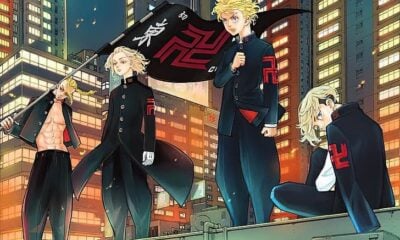
 Features2 weeks ago
Features2 weeks agoDon’t Miss This: Tokyo Revengers’ ‘Three Titans’ Arc Is What Fans Have Waited For!
-

 Uncategorized3 weeks ago
Uncategorized3 weeks agoSleep Meditation Music: The Key to Unwinding
-

 Guides2 weeks ago
Guides2 weeks agoHow to buy games on Steam without a credit card
-
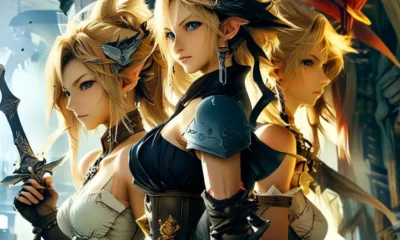
 Game Reviews2 weeks ago
Game Reviews2 weeks agoFinal Fantasy VII Rebirth Review: A Worthy Successor?
